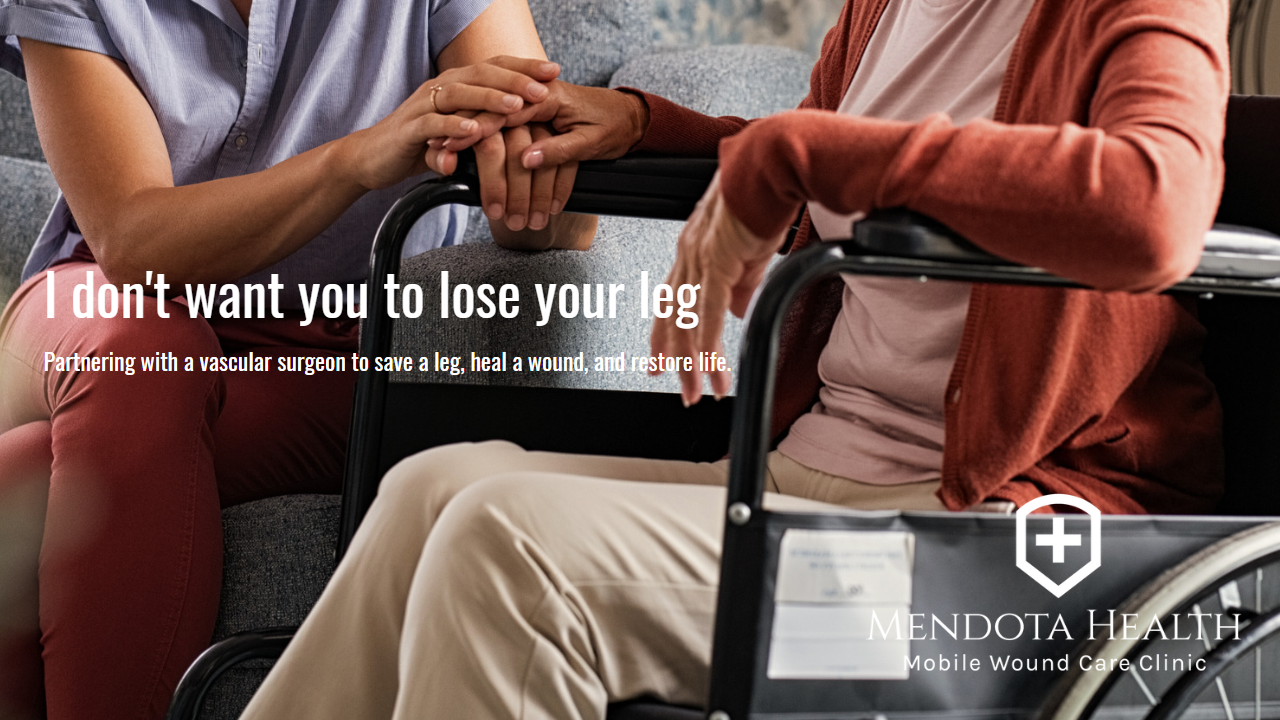
07 Jun I don’t want you to lose your leg
A conversation with Kathleen Gonzales, APRN, FNP-BC
It was September, the wounds I had been working on for the last three months were getting worse. I thought, “this woman is going to lose her leg”.
Many of the patients I, and my colleagues see, have been in and out of wound clinics, SNFs, seen by multiple clinicians, and they are tired, and their wounds are not healing. Mendota Health is called in when things are bad; when wounds have become chronic, infection is present, and conventional treatments are not working. You can imagine this is a difficult spot for a clinician to start from. Not only has the wound become worse, but the patient also isn’t excited to have yet another clinical person poking around. Wound healing is a collaborative process, it takes contributions by both the provider and the patient. I, as the medical provider, come with the medical know-how and expertise to heal the wound. The patient brings the will and commitment to take daily actions, like eating right or staying off the wound, to ensure the wound will heal.
Venous Stasis ulcers on both legs
When I first saw this patient, we’ll call her Debbie, she had eight wounds. She had venous stasis ulcers on both of her legs, and her left leg was far worse than her right. Because of the severity of the wound and Debbie’s lack of enthusiasm for participating in the healing process, I knew this was going to take some time. She wasn’t keeping her legs wrapped and following other instructions. At the very first visit I told her, “I can come in here with every advanced treatment known to man but, I need you to do your part”. I was straight with Debbie from the beginning. With most of my patients, including Debbie, I give them homework for the week that corresponds to my treatment plan. I have found this framework really helps them understand the importance of how their action or inaction impacts their wound healing. When she saw all I was doing to try and heal her wounds, and the time I was taking at each appointment, she started to come around. Debbie, like most patients I see, is accustomed to nurses coming in for a quick 20-minute appointment. But with me, I’m with her for an hour, sometimes for an hour and a half. This time commitment is impactful. Patients see I am actually taking the time to help them and understand them. Being present with patients for this amount of time helps me to build relationships and trust. Patients become more receptive to treatment and the instructions I give them after this.
Unfortunately, even with applying advanced treatments, and Debbie’s willingness to participate, her wounds were not progressing. She had an infection which I could treat but the leg was turning blue. There was an issue with blood flow to the tissue that I could not solve. I told Debbie, “This is it; I don’t want you to lose your leg. You need to go to the ER right now”. Even with this dramatic news, it still took a week of convincing to get her to go to the hospital.
This is it; I don't want you to lose your leg. You need to go to the ER right now.
Limb amputation increases risk of death
Limb amputation negatively impacts a person’s quality of life, and it is also puts them at a greater risk of death. Individuals who have lower limbs amputated for vascular disease or diabetes have a 1 year mortality rate of 54% (1). And potentially preventable amputations are increasing for patients who require inpatient hospital admission, present to the ED, or require outpatient interventional treatment (2). So, I knew I needed to communicate clearly with the hospital to ensure them I could heal Debbie’s wound and she doesn’t need to lose her leg if a vascular surgeon could just deal with the blood flow issue.
Working with a vascular surgeon
As a nurse practitioner with Mendota Health, I can’t admit patients to the hospital. So, I called the ER and told them there is a patient coming in, provided the background information, and let them know this patient needs to be assessed by a vascular surgeon. I had contacted a number of vascular surgeons in the area, but it was going to take months for her to get in for an appointment and by then there would be no way her leg would recover. Sending her to the ER was the best option to try and save her leg. A hospitalist doctor ended up admitting her and disregarded the information I had relayed to the intake nurse. And they disregarded everything the patient was saying.
Debbie’s leg was decompensating while she was in the ER, there was no way we were going to let her be sent home.
Debbie’s son called me and said “they’re trying to send my mom home!” Debbie’s leg was decompensating while she was in the ER, there was no way we were going to let her be sent home. I worked with him to advocate for his mom and finally he was able to convince the doctor to get a vascular surgeon to assess his mom.
After the assessment the vascular surgeon performed a procedure called a vascular seal which reroutes the blood flow. Basically, seal off the bad veins. The issue with her legs was not insufficient blood flow, it was that her veins weren’t able to return the blood. The surgeon was able to clamp off the diseased veins in her leg which helped get adequate flow back in the leg. We saw improvement immediately after this procedure was done. The vascular surgeon discharged the patient back to me and I was able to begin compression and advanced wound treatments like cellular tissue-based products. We instantly started seeing positive progression and wound healing. It was like fresh air.
healing wounds restoring life
We have now closed 7 out of the 8 wounds and Debbie is so much happier. When a person, like Debbie, has been dealing with the impact of large and chronic wounds, they are not going to be a happy person. What I love about this job is I get to see positive weekly progress. I get to see the patient become more themself, to see them become happier. Ultimately, I get to see them get back to living their life. And when a caregiver is involved, like Debbie’s son, I even see their mood and demeanor change. When the person you are caring for isn’t doing well, and nothing is working, that is mentally, emotionally, and physically exhausting for the caregiver. As soon as we started to see wound healing after the procedure, I could see some of that stress dissipate and joy come back into his life.
Debbie did not get out of her house for much of the past year. Now that she is doing better, she gets to go and sit out on her porch and enjoy the sunshine. She told me “I haven’t been out in months and now I can actually go out and walk around my yard!” It might seem like a simple thing for most people to be out in their yard enjoying the sunshine, but for Debbie, and my other patients who have not been able to experience this because of their wounds, it is life changing.
I am so grateful to the vascular surgeon and his willingness to collaborate with me to save Debbie’s legs and ultimately heal her wounds. Healing wounds really does take a multidisciplinary team of a wound specialist like me, sometimes another specialist like a vascular surgeon, and it always needs the willingness and commitment of the patient.
Kristensen, M. T., Holm, G., Kirketerp-Møller, K., Krasheninnikoff, M., & Gebuhr, P. (2012, May). Very low survival rates after non-traumatic lower limb amputation in a consecutive series: What to do?. Interactive cardiovascular and thoracic surgery. https://www.ncbi.nlm.nih.gov/pmc/articles/PMC3329303/
Humphries MD;Brunson A;Li CS;Melnikow J;Romano PS; (n.d.). Amputation trends for patients with lower extremity ulcers due to diabetes and peripheral artery disease using statewide data. Journal of vascular surgery. https://pubmed.ncbi.nlm.nih.gov/27670653/

